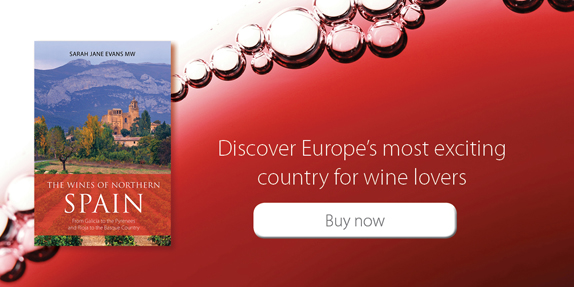A taste of excitement: why northern Spain is currently the place to get your wine kicks
4 May 2018 by Rebecca in Classic Wine Library, Wine and spirits
Spain is one of the world’s largest wine-producing countries. Over recent years the level of quality in wines has risen sharply and many neglected wine regions are finding new life on the world stage. Within the lifetime of many of today’s wine drinkers Spain has seen huge political, cultural and social changes, and these have had a positive effect on its wine industry.
Beyond the well known favourites of Rioja and the Tempranillo grape there is now a world of wine waiting to be discovered. So where should one begin the journey, what might we expect to find and who are the people behind these wines? So much is there to discover that the northern part of the country now merits an entire book in itself, The wines of northern Spain. In it, award-winning Spanish wine specialist Sarah Jane Evans MW delves into what she refers to as ‘the most exciting country in Europe for wine lovers’.
Perhaps the main thing that makes the country so exciting for the wine adventurer is the sheer variety on offer, for as Evans points out, ‘It is home to the new reds, the fresh, zesty Atlantic styles; the aromatic whites; the pale-coloured rosados; the traditional method sparklings; the sweet Moscatels; the wines aged under flor; and the wines from vines grown on slate, clay, limestone or sand, all expressing their origins.’
Across the regions producers are demonstrating confidence in their vinous roots and making a return to traditional varieties such as Garnacha, proving that with care in the vineyard and winery it can produce superb wines. And the northern half of Spain is also impressing with white wines that are not only pure but as sophisticated and intriguing as their red counterparts.
Evans also explores the more controversial issues, tackling the question of oak overuse and the winemakers’ efforts to create wines more suited to tastes beyond the local market, as well as addressing Spain’s history as a producer of bulk, rather than quality, wine. She also looks at current wine regulations, offering some thoughts on the way forward for the regions featured.
Clearly, attempting to include all of the area’s wine producers is not possible, so instead Evans focuses on those producers she feels are doing the most exciting work in field and cellar, and producing distinctive wines with a sense of place. She points out that the best way to understand the Spanish wine revolution is to try the wines for ourselves, and notes that while many of these wines are available outside Spain the best place to experience them is in their place of origin, alongside local food and among Spanish people. To aid our explorations she supplies a listing of some of her favourite restaurants and places to stay.
Whether or not you choose to pay a visit to the country The wines of northern Spain is the ideal gateway for all wishing to find out more about the wines of this rapidly evolving region.
Review copies available from marketing@infideas.com

